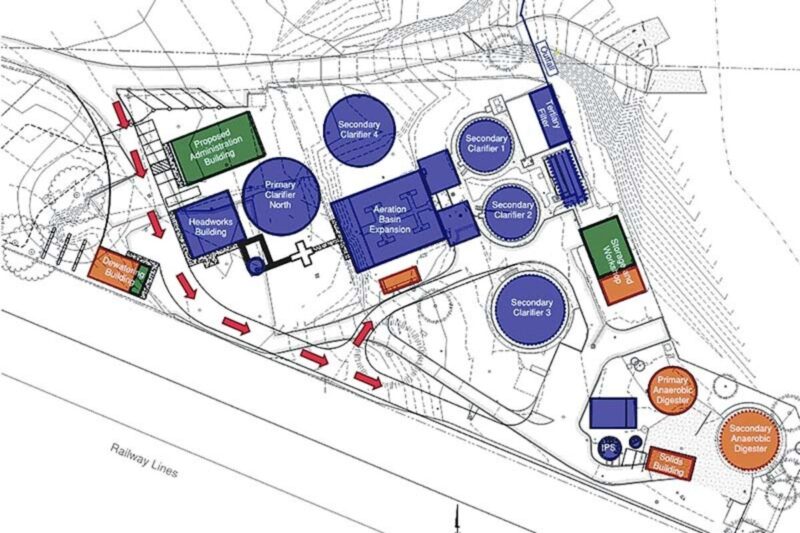Sean C. Morgan
If everything goes just right, City Manager Ray Towry told the City Council March 12, the project to rehabilitate and expand the city’s Wastewater Treatment Plan could be as much as 60 percent funded before construction even starts.
The project is the final step to avoiding bypasses of untreated sewage into the river during heavy rainstorms, a process that has continued for nearly 20 years. Prior to four sewer line replacement projects, during heavy rains, the city’s Wastewater Treatment Plant could receive up to 22 million gallons per day of flows. The plant is designed to handle a maximum flow of about 7 million gallons per day.
Nearly all of those flows are from storm and ground water. The city uses around 1 million gallons of water per day. During rainstorms, water can enter the sewer system through cracks in sewer pipes or even direct connections from storm drains. This is called inflow and infiltration, often shortened to I&I.
I&D leads to the plant bypassing highly diluted but untreated wastewater into the South Santiam River. The Oregon Department of Environmental Quality may levy fines for that violation.
From about 2000 to 2010, the city had an agreement with the DEQ to reduce I&I, and while the city was working on the problem, the DEQ agreed not to levy fines for bypasses.
Since 2000, Sweet Home has completed four major sewer line replacement and rehabilitation projects throughout the city, reducing I&I flows from as much as 22 million gallons per day to a maximum of about 12 million gallons per day.
Returns on further sewer line projects were unlikely to provide much “bang for the buck,” according to former Public Works Director Mike Adams, when he recommended the council expand the Wastewater Treatment Plant several years ago.
Initial plans put the price tag at $42 million. Representatives of Murraysmith, an engineering firm, told the City Council last year that they thought it could be completed for some $20 million less by rehabilitating the existing concrete and equipment in the plant, with some replacement and new construction.
Once complete, the project should be able to handle flows of up to 12 million gallons per day, more than twice the existing plant.
With ongoing improvements in the collections system, the new plant should need to handle a maximum of less than 12 million gallons per day, said Preston Van Meter, Murraysmith project manager.
Van Meter said Murraysmith is ready to take the project to a 20-percent schematic design level and will return to the City Council for approval soon.
The project will include a new headworks, which will screen large debris, such as rags, from the wastewater, Van Meter said. Right now, the plant has a grate that stops little from moving into the plant.
The aeration basin is inadequate, Van Meter said, and the dewatering facility is inadequate.
“We’re kind of at the whim of 1974 technology,” said Steven Haney, plant manager for Jacobs, which operates the city’s water and wastewater treatment plants. “If you gave me 1995 technology, I’d be thrilled.”
The Murraysmith project will do a lot better than that, Haney said.
The new plant will have an expanded aeration basin, Van Meter said. It will include two new clarifiers, an additional outflow, a new anaerobic digester and space designed to provide additional clarifiers in the future. It will replace the dewatering facility, and it will automate much of the plant, so it can be monitored and adjusted from a tablet or phone. It will eliminate the chlorine disinfection system for an ultraviolet system.
Much of the plant’s existing concrete is in good enough condition that it can be rehabilitated, Van Meter said, and that will save money, keeping sewer bills at less than $65 per month.
At $42 million for the project, consumer bills would reach as high as $95 per month, he said. At this point, Murraysmith is estimating the cost at $23.5 million.
Murraysmith is recommending additions to the project to address unanticipated challenges, including a replacement for the sand filter, a new administration building and a recycling program for the sludge byproduct, which is landfilled at a cost of $130,000 per year right now.
The sand filter system is difficult to operate, Van Meter said, and the pump can move only 2 to 4 million gallons per day. He suggested finding more effective filter technology to ensure compliance with mass loading regulations.
The administration building is too small, he said. It doesn’t have enough space for the lab among other issues, a lack of a women’s locker room, handicap accessibility and a poor layout for chemical storage, which is located next to the break room.
Van Meter said that the city could turn sludge into marketable compost on a couple of acres. That could be used in the parks or by residents. The city could sell it or give it away instead of hauling it to a landfill.
These projects would add another $4.7 million to the project, he said, a total of $28.2 million.
The city is projecting a savings of $7 million in funding through the current rate structure, he said. It also has $2 million in earmarked funds from the state legislature with the possibility of another $3 million in the current legislative session. A U.S. Department of Agriculture grant could fund up to 25 percent of the unfunded portion of the project.
That would be 60 percent of the funding of the total project, Van Meter said, an unusually high level of funding at this stage of this type of project.
“We are hopeful,” Towry told The New Era. “If the stars align,” if nothing unforeseen occurs and the city can secure all of that funding, then it would be 60 percent.
His personal goal was 50 percent, he said, and he said he would be ecstatic if the city went into the project with $11 or $12 million.
The city was scheduled to hold a public hearing on Tuesday, March 26, and will hold another on April 9 at the Sweet Home Police Department, 1950 Main St., to receive input on the project and answer questions. The deadline to go into the final design step is April 23. Final design is scheduled for completion by the end of September 2020, with bidding in early 2021 and construction beginning in April 2021.
Councilor Dave Trask expressed appreciation for the economizing strategies. The project was estimated at $35 million initially, he said. Later, it moved to $42 million.
It’s “impressive where it is now,” Trask said.





